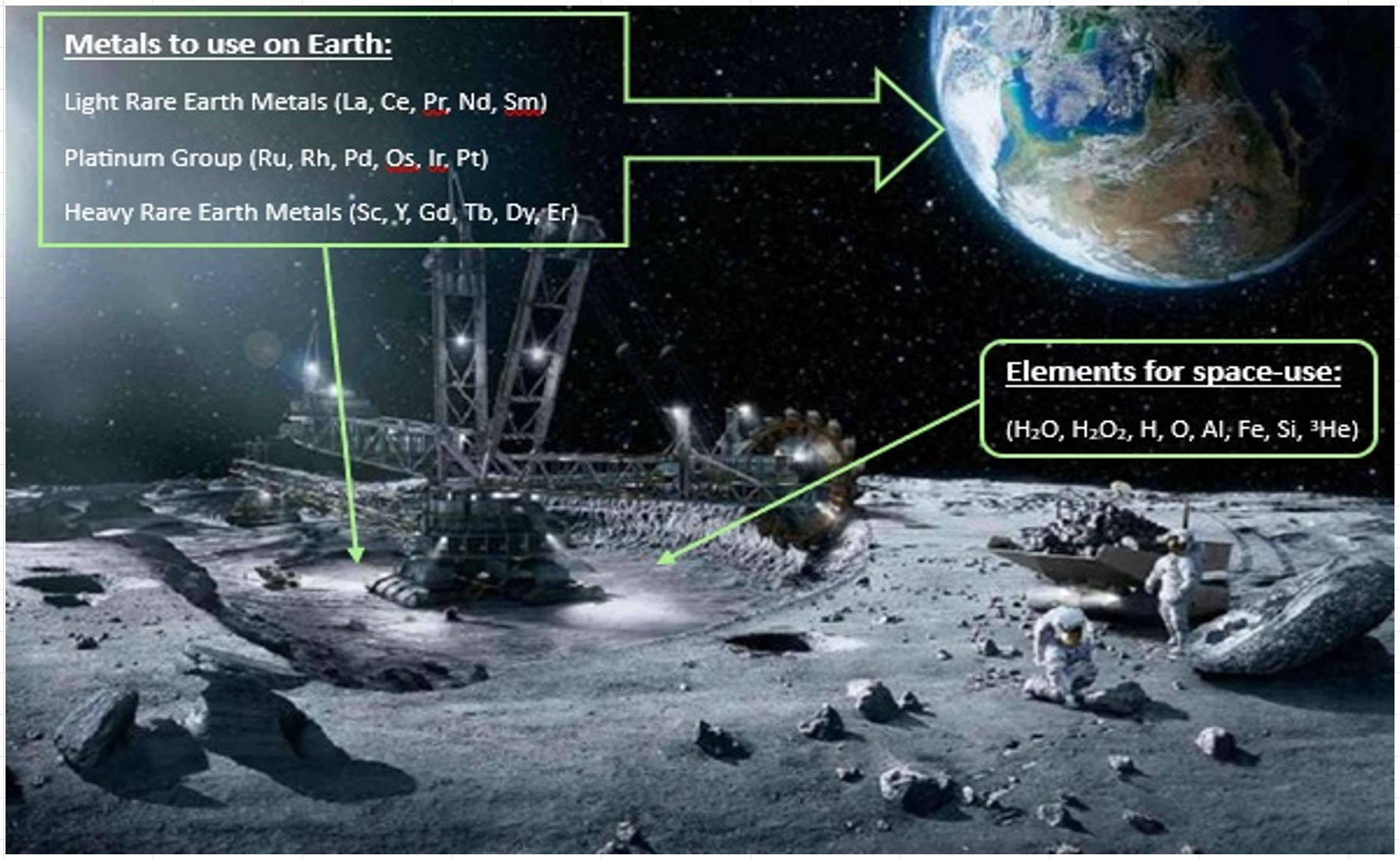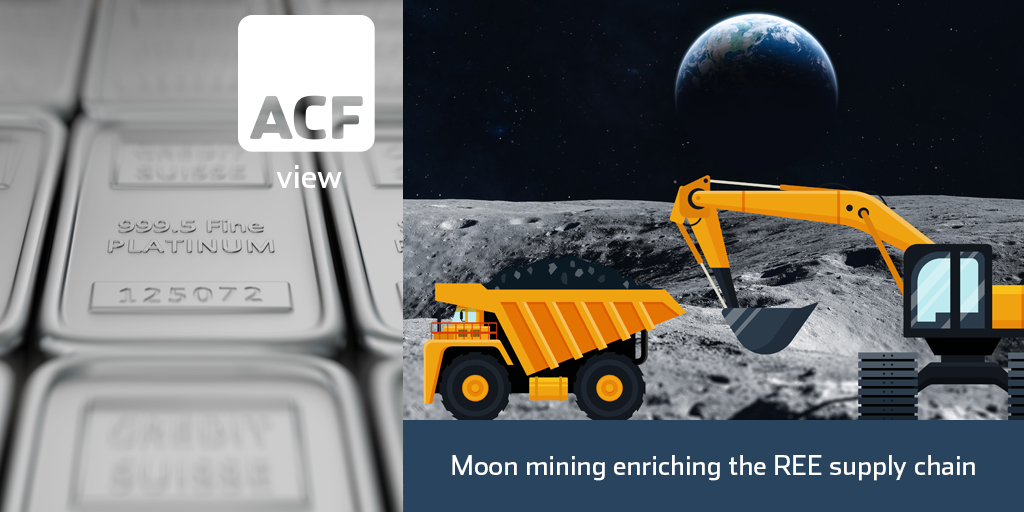Moon mining – the next Extractives frontier
Moon mining could become the next extractives frontier by 2032 providing a source of rare earth metals that are essential for modern technology, such as smartphones, X-rays and televisions and considered to be a serious constriction concern for zero emissions plans.
Mining on the Moon could also have a positive impact on the Earth’s environment, by reducing the need for extracting resources from the Earth and potentially relocating polluting industries off-Earth.
Moon mining could also be a potential source of water (H2O), oxygen (O) and hydrogen (H) used for human life support and rocket fuel. In turn this could make further exploration and development of the Moon self-sustaining in certain key areas.
Moon extracted supplies of H2O and H may also open up possibilities for work in cislunar space i.e. the extended Solar System environment in the vicinity of the Earth and Moon.
Associated activities would likely include new scientific research activities alongside economic activities. Associated infrastructure would inevitably need to include lunar bases, observatories, power stations and factories. It seems a big step in just a decade.
NASA is already leading the way. As part of its Artemis mission, NASA is planning to launch a pilot processing plant for lunar resources by 2032. It plans to build a permanent moon-orbiting base (called Gateway) that is similar to the International Space Station (ISS).
- According to the data collected by NASA’s Lunar Reconnaissance Orbiter (LRO) spacecraft, the moon is expected to be rich in metals (e.g. iron ore, titanium) and three very important elements – water (H2O), helium-3 (3 He) and rare earth metals (Mining Technology, 2020).
- The Australian Space Agency is developing a semi-autonomous rover to extract regolith samples (loose material covering the surface of the moon on a NASA mission by 2026. The rover will search for oxygen containing soil and extract the O2 gas from it (Interesting Engineering, 2023).
While Moon mining is no longer something for the distant future, the expansion of mining grounds into space presents several potential benefits as well as challenges. We showcase them below:
Benefits
- Enriching the rare earth metals supply chain facilitated by the existence of lunar rare earth metals like scandium (Sc), yttrium (Y) and the 15 lanthanides (metallic chemical elements with atomic numbers 57-71), (Boeing, 2021).
Exhibit 1 – Enhancing the rare earth metals supply chain
 Sources: ACF Equity Research Graphics; Wallpapers.com.
Sources: ACF Equity Research Graphics; Wallpapers.com.
- Encouraging technological innovations and advancements
- Space focused companies, such as SpaceX (private) and Blue Origin (private) are working on developing space technology and robotics to make Moon mining more feasible.
- A lunar mining plant will require innovative mining technologies like automated space prospecting and mining machinery and remote-controlled and minimal human oversight pumps.
- Human settlement on the Moon is possible based on lunar water and potential building solutions from companies providing 3D printing solutions and products.
- Supporting regulations
- Space focused companies, such as SpaceX (private) and Blue Origin (private) are working on developing space technology and robotics to make Moon mining more feasible.
- United States Ex-President Trump’s Executive Order 13914 on “Encouraging International Support for the Recovery and Use of Space Resources” signed in Apr 2020.
- Luxembourg’s Law on the Exploration and Use of Space Resources passed in Aug 2017.
- United Nations Office for Outer Space Affairs (UNOOSA) Outer Space Treaty signed in Jan 1967 with [now] 114 countries party to the treaty.
- Further space exploration
- Sustainable human establishments on the Moon might represent a steppingstone for future missions to Mars and beyond. By using in-situ resources (ISRU) Moon launching missions could (we remain somewhat cautious here) be less expensive and complex versus exploration initiated from Earth.
- Our caution here is based on total cost and time scales to delivering savings etc. A better argument might be supply chain diversification.
Challenges
Technological challenges – Developing Moon mining requires the completion and testing of new technological approaches – no one should underestimate just how harsh and challenging the lunar environment is for technology.
ESG (economic, social governance) – Although scientific research is yet to reveal that lunar mining would damage the Moon environment, there are potential ethical concern for future generations and the visual impact from Earth and we seem to know little of the Moon’s own systems or how large scale human driven activity could impact these systems.
Legal proprietary concerns – The Outer Space Treaty presents legal global challenges and the framework is still under development, so further international collaboration is required. The days of empire flag posting seem relatively unthinkable with their obvious pathway to armed conflict on earth.
High capex costs – Despite potential operational cost (opex) reductions for space missions, business cases are difficult to close in a time frame that meets investors’ desires (Boeing, 2023). Capex numbers are likely to be eyewatering in comparison to large scale innovation engineering projects such as sub-sea tunnels (Eurotunnel II) and high speed train lines (HS2).
RoI, ROIC, ROCE and DCF modelling may demonstrate that timescales, risks and return profiles are unmanageable or de-facto valueless for businesses and investors without governments taking on the much of the initial infrastructure capex role.
Transportation logistics – Transporting resources back to Earth from the Moon involves complex planning, education and project management. This remains perhaps the most important and perhaps least explored and written about aspect – getting the product back to Earth in a safe and economically attractive way.
Moon mining is no longer just novelist fantasy. Projects that begin to make Moon mining real are on their way to entering public perception. Infrastructure development, increased private investment, i.e. creating market niches for space and tech companies, legal/regulatory clarity and cohesion, and sustainable best practices will work towards making Moon mining a viable alternative to mining on Earth.
That’s a lot to achieve in a decade but clearly there are a range of corporate leaders who have set a decade as a ‘deadline’ – a goal is usefully described as a dream with a plan. Humans, we would argue, have proved good at achieving goals.




















